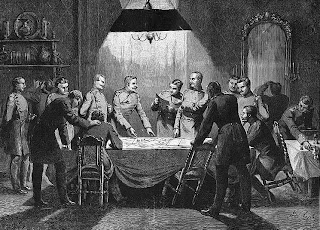Hi all,
and yes, welcome to the first Christmas reference of 2012 on HoP- yes, only 44 days left to ask for all the shiny toys you want the Fat Man to deliver. Also, time for the first in a set of weekly articles on wargames past, and the history of this here hobby (thank to Auberoun for the inspiration). To kick off, here's a roughly accepted timeline:
5th Century BC. The Greeks start playing Petteia, before passing it on to the Romans. It is rumoured that they learned the game from the Egyptians (based on a game called "Senet"), however there is little historical evidence for this. For anyone wanting to try an approximation, check this out.
6th Century AD. We get Chess, out of India (yes, that's India, not China.)
1811. Leopold von Reisswitz and his son Georg, Prussian army officers, create "Kreigsspiel", an advanced wargame using specialist pieces, dice and a Gamesmaster. In 1824 they present it to King Friedrich Wilhelm III (a refined version, heavily "playtested") and over the next 50 years it gains popularity- essentially, this is the Grandfather of modern Wargaming. It is currently available.
1911. HG Wells publishes "Floor Games", a pre-cursor to his more famous "Little Wars." Traditionally, Wells is recognised as the father of wargaming. Anyone wanting to try his rules with their existing models feel free- it is a dice-less system. Instead, combat is resolved by shooting the models with rifles (yes, actual guns) like a toy-soldier Subbuteo. Hopefully, GW never employ this as a strategy to sell more models....
From here we get a few wargames, and the hobby starts to open up, as rules become available to the public rather than the military. Here's a few high points:
1957. Jack Scrubby founds Scrubby Miniatures (using cheap rubber moulds) and promotes affordable wargames through War Game Digest. This is the first time that enthusiasts (proto-hobbyists) get in touch with each other and start sharing ideas.
1950's. Donald Featherstone. The man, the legend. Coming from a military wargaming background, Mr. Featherstone starts writing a series of books about wargaming. Combined with a flurry of companies making toy soldiers, this is really the birth of the Industry as we know it today.
1952. The start of Avalon Hill, who are almost single-handedly responsible for the birth of board-game wargaming.
The 1970's. The boom period for wargaming (yes, pre GW)- companies experiment with scale, subject matter (they venture into Fantasy and Sci-Fi) and style. This is coupled with the popularity of RPG's.
The 1980's. GW. Warhammer.
2000+ Another boom? Again, we have lots of companies, lots of new ideas and mini-successes. The internet has replaced the magazines, and now hobbyists are even more connected.
So that's where it all came from, for those that were wondering. I'll admit that this post is a little self indulgent (I love wargaming history, as well as historical wargaming). Over the next few weeks, I'll keep it more focused on the "modern era", and take a look at some of the gone but not forgotten games from the last 30 years (mainly GW, it should be said.)
As an aside, the working title on my desktop for these articles is "Olde Weirde's Crapticus", to pay homage to a set of articles I miss from the past....
Comments, as always, are welcome.



No comments:
Post a Comment